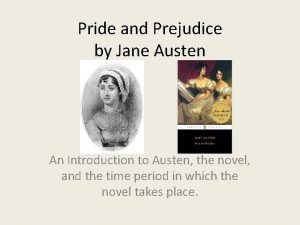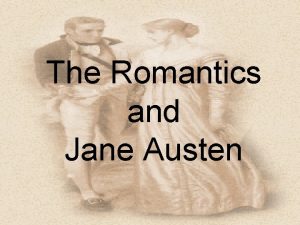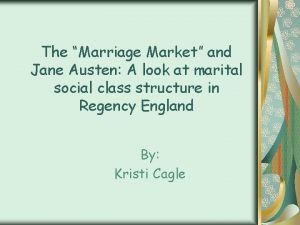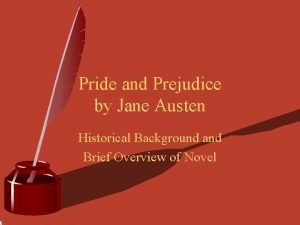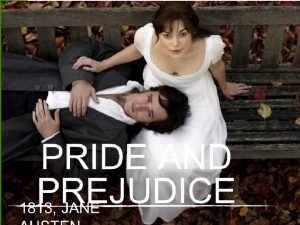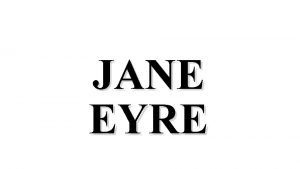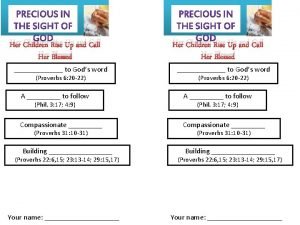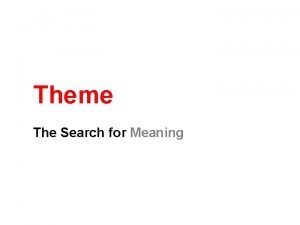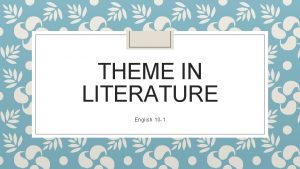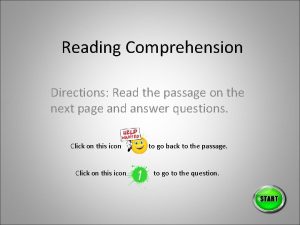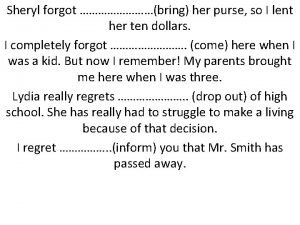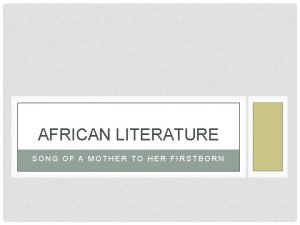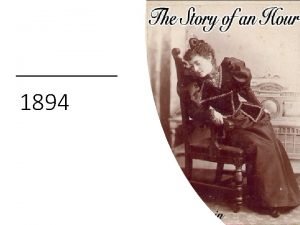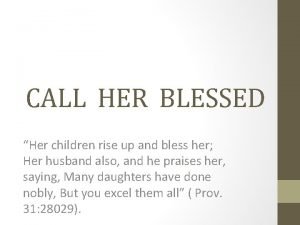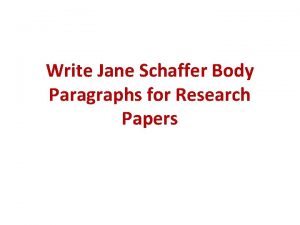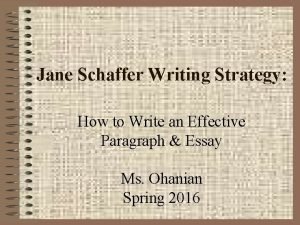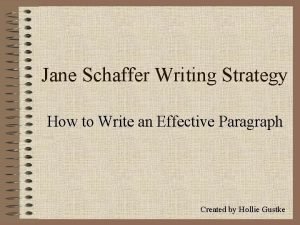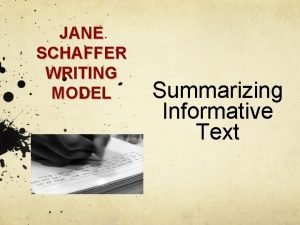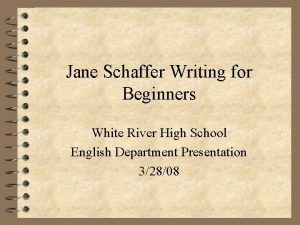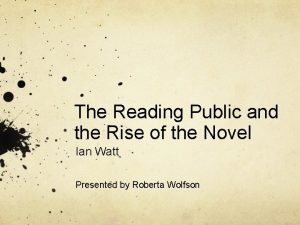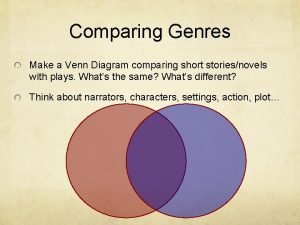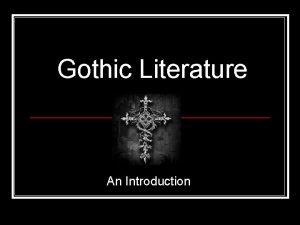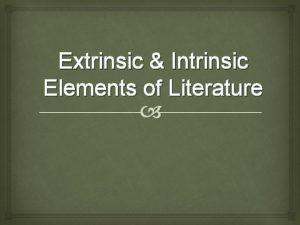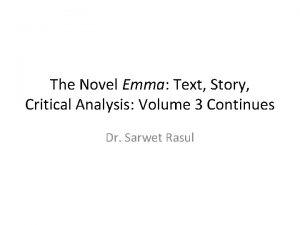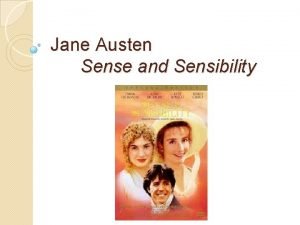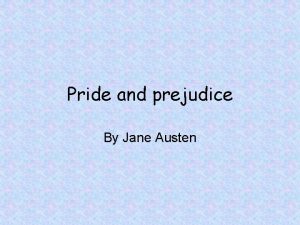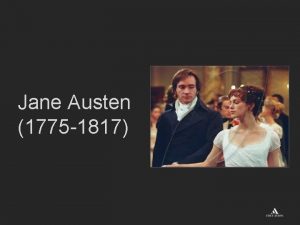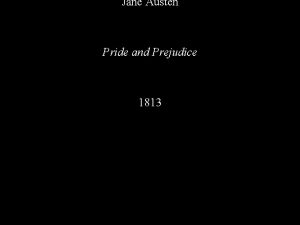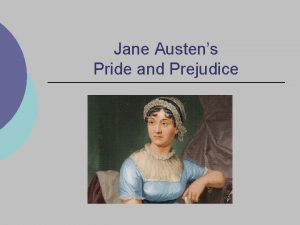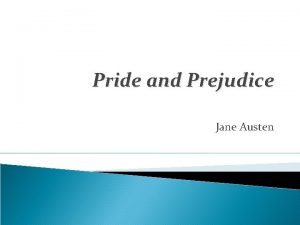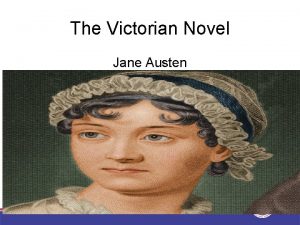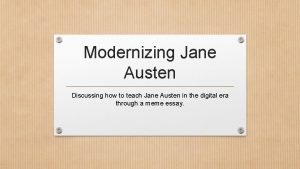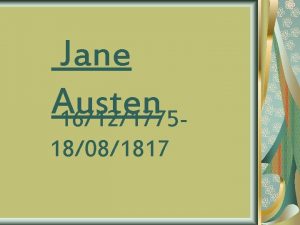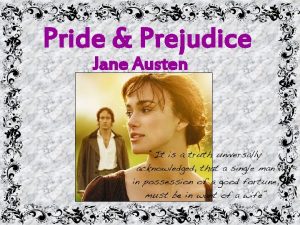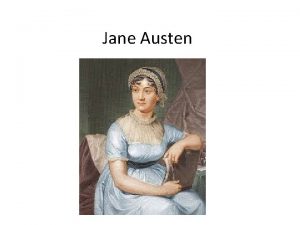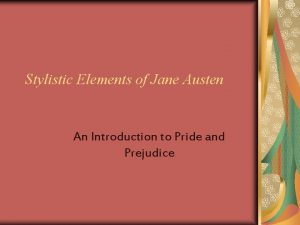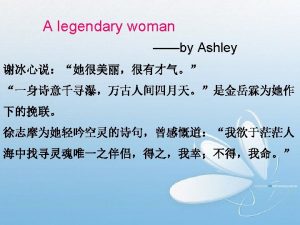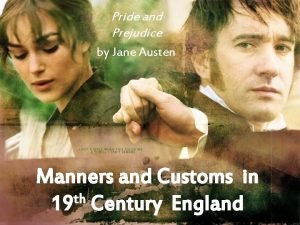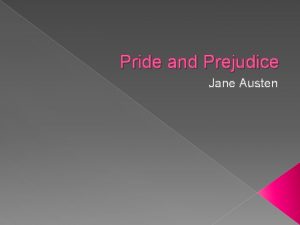Introduction to Jane Austen and her Novel Emma







































- Slides: 39

Introduction to Jane Austen and her Novel Emma Dr. Sarwet Rasul

About the Author: Jane Austen BIRTH AND EARLY LIFE: • Jane Austen was born in Steventon, England, on December 16, 1775. • She was the seventh of eight children of which there were six boys and two girls. • As far as her family background is concerned, her father was a preacher, and the family lived a modest life at the rectory. • As her father was a country clergyman, the rector of Steventon in the county of Hampshire in south-central England, this provided her but a chance to have a contact with the limited world of provincial gentry. • Education was an important trait of the family. Her father was a classics scholar in addition to a preacher. • All the children were schooled at home, but Austen also spent several years studying at a school away from home. • In fact she accompanied her elder sister Cassandra to two boarding schools only to return home at the age of nine to remain there. • Her childhood was a happy childhood with all the privileges of childhood that such a family would offer to its children. 2

Cont… About the Author: Jane Austen BIRTH AND EARLY LIFE: • As all the children were schooled at home, and Austen lived with siblings it was of great impact. • This experience of living in a closely linked family in a limited social context had a life long experience on Austen. 3

About the Author: Jane Austen • EARLY LIFE AND FAMILY ENVIRONMENT: • The family provided a lot of opportunities for learning. The family members often read aloud to each other and performed plays. • In the evenings while the children would learn needlework and do other domestic activities, there were loud readings that were shared by the family. Also the Austens were a novel-reading family. Of course this played a very important role in developing her interest in novels. • But her future career as a novelist was based on her education that she received in the provincial community in which she spent her early childhood and girlhood. After on as a mature novelist once she wrote in a letter stating that "such a spot is the delight of my life; three or four families in a country village is the very thing to work on. " • Anyhow it was for the fact that everyone encouraged her, that Austen's talent and intellect was channelized properly. Due to this support she began writing during her teenage years. 4

EARLY LIFE AND FAMILY ENVIRONMENT: • The family moved from there when her father retired, and moved to Southampton in 1805 after her father's death. • She lived in Southampton until 1809, when she moved to Chawton. 5

Her environment • • She had the experience of only this kind of limited provincial life. Of course she loved this life. All her work as a novelist is heavily inspired by this experience. To live a life beyond this experience was not of interest for her. In fact there was a small interval during which she lived a different kind of life in the artificial urban setup. And, it may be significant that during that interval she was unable to achieve any known completed work. This eight-year period began in 1801 when Mr. Austen gave up the living of Steventon and retired to Bath, the area of England most associated with Jane Austen, was her home only for four years, from 1801 to 1805. After his death in 1805 the mother and daughters moved to Southampton, where they remained until in 1809. Then they moved to the little town of Chawton. 6

Her environment • The period during Austen's residence in Bath and Southampton was a passive one from a literary perspective. • Austen wrote little during this time. • Being too much engaged in traveling and other social engagements kept her busy in Bath. When in Southampton she was troubled by city life. 7

• • Issue of Marriage: Marriage is one of the predominant themes of all her novels. But, when it comes to her personal life, Jane Austen decided not to marry. She lived a kind off life where much about personal life was kept away from the eye of the public so there exists almost no evidence to support any emotional involvement with any man. May be the reason is that most of her more intimate letters were destroyed. Being unmarried in one's twenties qualified one as a spinster, but Austen accepted and then quickly rejected a proposal made to her at the age of twenty-seven. There is also some rumors about her childhood attraction to somebody but nothing as such can be said with assurance. Her family background and her personal preferences lead to a protected private life; and as such there is no record of her complaining about her single life. Thus, she dedicated her life to her writing. 8

Jane Austen as a Novelist • • • Austen worked hard on her novels, constantly revising them. She wrote her first work when she was only of fifteen years. It was a satire. It was in 1790 s that she started writing most of here novels. Thus Sense and Sensibility, Pride and Prejudice, and Northanger Abbey were all started during this time. However, since she revised and edited each of her works heavily before they were published, so there was a lot of delay in the publication of her works. Anyhow, Before 1801, while Jane was still in her early twenties, she had written three unpublished novels: Pride and Prejudice, Sense and Sensibility, and Northanger Abbey. 9

Jane Austen as a Novelist • Sense and Sensibility was not published until 1811. • Pride and Prejudice appeared in 1813. • Mansfield Park was published in 1814, and Emma appeared in 1816. • Publishing her novels was important to Austen, though nearly all were published long after they were written. • Northanger Abbey and Persuasion were published posthumously that is after her death. • Her desire to publish anonymously was not unusual. In the times she lived as a woman writer, fame could often lead to problems so she preferred to publish anonymously. • It was only after her death in 1818, that a biographical note was added to her novels and people started knowing her as the author of her novels. 10

Jane Austin as a Great Novelist • The novelist Virginia Woolf said of Jane Austen, "Of all the great writers she is the most difficult to catch in the act of greatness. " • Austen was a keen observer of social class and customs, and Emma is no exception. • She had family and friends read and rate the book, and many preferred other of her works. But readers liked Emma, both novel and character, and this admiration is a credit to the author's skill. • Though a master of prose and observation, Austen did not receive much acclaim by the time she died of Addison's disease in 1817. • Today she is a highly respected and well-read author. 11

Jane Austen as the author of EMMA • • • EMMA was written from January 21, 1814, to March 29, 1815. Pride and Prejudice is generally considered to be Jane Austen's most widely read and most popular novel. But as far as the perfection of art is concerned, most of the critics believe EMMA to be superior. As an artist this is the masterpiece of Austen out of all her six completed novels. Austen herself saids she had created "a heroine whom no one but myself will much like. “ A comical book largely about Emma's errors of judgment, Austen adeptly keeps us from disliking her blundering heroine. Since Emma was written at a time when Jane Austen had attained maturity as a writer, and she had reached a calm high point in her development as an artist, a point of steady, relaxed control over both her subject matter and her technique, the novel reflects this maturity and grip. 12

The Novel EMMA • • • “Emma” was the last of Austen’s novels to be published before her death. It was published anonymously like all her earlier works. Shortly before the publication of “Emma, ” Austen was invited to meet with the Prince Regent’s librarian, who encouraged her to dedicate her next novel to the Prince Regent a great admirer of her work. Although Austen was not particularly fond of the Prince, she chose to follow the librarian’s suggestion and later satirized her meeting with him in “Plan of a Novel, according to hints from various quarters. ” There were two thousand copies of “Emma” printed in the first edition. Unfortunately more than five hundred were unsold even after four years of its publication. However, the novel was generally well-received by the public. Unfortunately, Austen earned very little from its publication as most of the profits were used for the ill-timed printing of a second edition of “ Mansfield Park” a few months later, and she ended up earning only 40 pounds from the novel in her lifetime. 13

What EMMA is about? • • • “Emma” is different from all other works of Austen because, unlike her other novels, the work focuses on a wealthy and beautiful heroine with no financial concerns or need to marry. The quest for financial security and an appropriate husband is central to her other works and adds a serious element to their narrative structures of those novels. In contrast to these “Emma” is written in a lighter tone, with a streak of humour and as such without being based on a dramatic conflict. The heroine of the novel is also unique because of her seeming immunity to romantic sensibility. It is only at the end of the work that the heroine is shown to be interested in love; before that point, she shows minimal romantic interest in any of the male characters. 14

Reception of EMMA and her other works • • Because Austen’s works were published anonymously, they received little critical attention during her time period. Although her books sold well and were favored by prominent figures in British society. Austen received only a few short reviews. After her death, her works continued to be steady sellers but were not widely popular among readers in the 19 th century. In general, audiences preferred the dramatic style of George Eliot and Charles Dickens over Austen’s mild projection of the limited life of provincial British society. 15

Reception of EMMA and her other works • • • However, Austen’s work was still highly praised by prominent literary scholars. Authors Sir Walter Scott and Henry James and philosopher George Henry Lewes lauded Austen’s narrative style; Henry James, in particular, compared her writing to that of Shakespeare, Cervantes, and Henry Fielding. After James Edward Austen-Leigh published his biography of his “dear aunt Jane” in 1869, Austen was introduced to the wider public, who clamored for new editions of her works. Austen-Leigh’s biography also spurred a rift between the literary elite, who called themselves “Janeites, ” and the larger public, who was presumed not to properly understand her works. In the 20 th century, Austen’s works began to receive major scholarly attention, specifically with the publication of A. C. Bradley’s essay on Austen in 1911. The 20 th century also saw a surge of adaptations of Austen’s works, including films, prequels, sequels, and revised novels. “Emma, ” in particular, has been adapted for film multiple times, including the 1995 film “Clueless” with Alicia Silverstone. 16

More About Emma • • • Emma, like Jane Austen's other novels, deals with the subject of young ladies finding proper husbands. On the surface this is what the story line of Emma is about. However, beneath the surface the book concerns much more than that. Jane Austen is mainly concerned with the way people behave. Within the chosen limits of upper-middle-class society and within the even more limited strict feminine point of view for telling the story we find her mastery of art to present the detailed picture of this kind of life. All the events are presented from within a domestic or social context, though not, as has been claimed, merely from within a drawing room. And this is the broad area of the moralist. If the moralist chooses, as Miss Austen does, to focus on the common rather than the exceptional behavior of people, s/he is more likely to write comedy than tragedy. 17

More on What EMMA is About? • A tunnel vision • A drawing room story • A superficial view of life BUT • A very clear vision • A picture with details • A true picture 18

Character List • Emma Woodhouse: "Handsome, clever and rich, " Emma is a twenty-one year old daughter of a wealthy gentleman. She is the imaginative and self-deceived heroine of the novel who is very much accustomed to "having her own way" and has a "disposition to think a little too well of herself”. Her main job as such is to be companion of her widower father. Although a meddler who demonstrates a maddening self-confidence, Emma is generally well intentioned. Her hobby throughout the novel is match- making. The novel is essentially a story of how Emma matures from a clever young woman to a more modest and considerate woman, able to accept the idea of love. • Henry Woodhouse: He is Emma's father. He always resists any kind of change, compensating somewhat for his selfish whims by being kindly and concerned about people's health. • George Knightley A well-to-do man of about thirty-seven or thirty-eight. He is a very calm and rational man who for years has befriended and advised Emma. His personality fills in all the gaps that we see in the maturity of Emma. Courteous, noble, sincere and intelligent, he is a paragon for behavior, yet not afraid to correct Emma for her mistakes. His brother had married Emma's elder sister, Isabella. He marries Emma at the end of the novel. • • 19

Character List • Miss Anne Taylor: She is Emma's devoted governess and friend since long. At the beginning of the novel she has just married Mr. Weston. • Mr. Weston A near neighbor to the Woodhouses, whose son by a former marriage is Frank Churchill. • Philip Elton: He is the rector of Highbury. He is a twenty-six-yearold clergyman, and one of the most eligible bachelors in the area. • Frank Churchill Mr. Weston's son, who has never visited Highbury but who has a reputation for his manners and sophistication. 20

Character List • Jane Fairfax Miss Bates' orphan niece, elegant and accomplished, who has visited her aunt in Highbury before but not for two years now. • Harriet Smith The illegitimate, seventeen-year-old girl. She is a short, plump and fair girl in appearance. Emma is mostly responsible for bringing Harriet into Highbury society and constantly instructs and advises her, although not always to her benefit. Emma fills her with a pretension that is inappropriate for her status. Emma tries to marry her off to Mr. Elton. In the end, she marries Mr. Martin, a farmer that Emma considers too coarse but is more appropriate in status for Harriet. • Robert Martin A respected young farmer who wants to marry Harriet Smith. Augusta Hawkins A vain and talkative young lady whom Mr. Elton meets on a trip to Bath and to whom he quickly gets himself engaged. • 21

• • • Major or main theme of EMMA Common human absurdities Not exceptional absurdities of tragedy such as presented by Swift in his satire Rather she dealt with those that are more common and frequent, and more laughable ones of society. These human absurdities are more based on code of manners, and its fabricated engagement of man's time, thought, and energy as such in the system of a society. Beneath Austen's satiric comedy is a moralistic realism. I would like you to compare this with Fielding’s moralistic works. By picturing the real incongruities of social matters, she implies what may be right: the ideal balance between head and heart, between common sense and goodness, between rationality and imagination or emotion. Hers is not a naturalistic world inimical to or destructive of the individual. Rather, it is a fairly stable social world that operates comfortably as long as there is no major aberration from it. It can, in fact (if we judge from the outcome of the story), operate effectively in spite of an aberration, secure that the deviation can be rectified and absorbed so that the deviant (Emma) finds and accepts her proper place. 22

Cont… Major or main theme of EMMA • • It is against this background that Emma pursues her willful and subsequently crossed-purpose way. In the end her change is not into something new and different from her time and place, but into something that is the standard of her environment. Her change is not the kind associated with a liberal idea of progress, but the kind found in the conservative idea of progress: she develops into, not out of, a social tradition. Thematic Irony: A major thematic irony of the book is that at the end Austen enables the reader to understand that as such there was never any real danger to the environmental fabric within which Emma was operating. Nor there was threat of any change in this social fabric because of Emma. 23

Cont… Major or main theme of EMMA • This triumph of this social order or social world does, however, mean that it is necessarily the best of its kind. • The beauty of the whole novel is its thematic satire at the expense of the manners and people of this world throughout the text. • This mildness of satire is the unique quality of Jane Austen. 24

Other Important Themes • Courtship and Marriage • Emma is structured around a number of marriages. • All the time the plot and story revolve around some recently consummated marriage or an anticipated marriage. • In fact in all of Austen’s novels, courtship and marriage play major roles. • As far as “Emma” is concerned the entire novel is structured around various courtships and romantic connections, from Harriet and Robert Martin to Jane Fairfax and Frank Churchill to Emma and Mr. Knightley. • All of the conflicts in the novel also revolve around this topic, particularly in terms of characters striving to find appropriate matches. In this way, Austen presents marriage as a fundamental aspect of society during the time period. 25

Other Important Themes • • Inter-relationship of Marriage and Social Status Social status is the keyword in all these marriages. In Jan Austen’s works marriage not only promotes families and serves romantic purposes, it also upholds the class structure of the community by ensuring that individuals marry appropriately and according to their status. We can see examples of this marriage and social class matching in the case of Harriet and Robert Martin for example, who are from the same class. 26

Cont… Inter-relationship of Marriage and Social Status • • • At the same time, Austen also uses marriage to highlight the social limitations faced by Emma and other characters: in their small village, marriage and courtship are the sole catalysts of excitement or conflict. The institution of marriage itself plays a vital role in solidifying the participant’s social status. This leads to the question of as to what was meant by social status during Austen’s times. Well, in Austen’s time, social status was determined by a combination of family background, reputation, and wealth. And, marriage was one of the main channels through which one could have the possibilities of changing his or her social status. It could raise one’s social status. This method of social advancement was especially crucial to women, who were denied the possibility of improving their status through hard work or personal achievement. 27

Cont… Other Important Themes Cont… Inter-relationship of Marriage and Social Status • The novel suggests, marrying too far above oneself leads to strife. Mr. Weston’s first marriage to Miss Churchill had ostensibly been a good move for him, because she came from a wealthy and well-connected family whereas Mr. Weston is a tradesman. • What Austen points out is that the dis-balance and inequality of the relationship caused hardship to both. • He marries Mrs. Weston just prior to the novel’s opening, and this second marriage is happier because their social statuses are more equal—Mrs. Weston is a governess, and thus very fortunate to be rescued from her need to work by her marriage. • On the same grounds Emma’s attempt to match Harriet with Mr. Elton is considered by the other characters as inappropriate. 28

Cont… Other Important Themes Cont… Inter-relationship of Marriage and Social Status • The relationship between marriage and social status creates hardship for other characters. Frank Churchill must keep his engagement to the orphan Jane Fairfax secret because his wealthy aunt would disapprove. Jane, in the absence of a good match, is forced to consider taking the position of a governess. The unmarried Miss Bates is threatened with increasing poverty without a husband to take care of her and her mother. Finally, the match between Emma and Mr. Knightley is considered a good one not only because they are well matched in temperament but also because they are well matched in social class. 29

Cont… Other Important Themes • Social class and role as a member of a social class • Austen highlights theme of social class throughout the novel, particularly in terms of Emma’s relationship with Harriet Smith. • As a member of the wealthiest family in Highbury, Emma holds the highest social position in the community. • While she interacts with other characters at an equal level (such as Mr. Knightley), she also has social responsibilities to less fortunate individuals, such as Miss Bates, Harriet Smith, and the poor families who live on her estate. • Jane Austen believes in the importance of class distinctions. • At the same time we see that Jane Austen encourages compassion and charity in members of the higher classes. 30

Cont… Other Important Themes • • The Confined and Limited Existence of Women: The novel presents a tunnel view of social life. It presents even a narrower and almost claustrophobic scope of action throughout. Women as the live, think and act in the novel give us a strong sense of the confined nature of a woman’s existence in early-nineteenth-century rural England. Emma as a young potential girl has a great deal of intelligence and energy, but the best use she can make of these is to attempt to make matches of people around such as her friends, servants etc. Despite being a member of the privileged class of the society, she does not have much alternatives in life to do something or to be involved in some activity. The novel show that the maximum she can do is to pay social visits, charity visits, to play Participating in the rituals of courtship and accepting or rejecting proposals is perhaps the most active role that women are permitted to play in Emma’s world. 31

Cont… Other Important Themes • Economic Oppression of women • As a heroine, Emma possesses beauty, wealth, intelligence, high social standing, and financial independence. However, Austen makes it clear that Emma is unique in her position; most of the women in the novel lack Emma’s financial independence and, as a result, have much more limited options for their futures. • Most occupations were thought to be inappropriate for women. • Women could not support themselves economically. • Either to marry or to work as a governess are the limited options available to them. 32

Cont… Other Important Themes Biasness and the Blinding Power of Imagination • Austen uses the novel to convey her an important theme of biasness. The novel offers sharply critical illustrations of the ways in which personal biases or desires blind objective judgment. • Emma is misguided by her imagination in the understanding of various characters and their behavior such as she cannot understand the motives that guide Mr. Elton’s behavior because she imagines that he is in love with Harriet. 33

Cont… Other Important Themes • Miscommunication and Misunderstanding • Many of the major conflicts in the novel are a direct result of miscommunication between characters. • One major example is Mr. Elton’s courtship of Emma during which Emma assumes that Mr. Elton is actually courting Harriet Smith. This misconception goes a long way in the novel. 34

Cont… Other Important Themes • Moral relativism • For the majority of the novel, Emma operates under the assumption that she knows what is best for those around her. A prime example of this is Emma’s relationship with Harriet Smith, in which Emma assumes that she has the right to determine Harriet’s choice of husband future happiness. She even takes responsibility for Harriet’s personality: taking it upon herself to “improve” Harriet. Emma indulges in similarly condescending behavior with many other characters in the novel, including Mr. and Mrs. Weston, her sister and father, Mr. Elton, and Frank Churchill. Emma’s belief in her own infallibility is undermined by her behavior toward Miss Bates at the picnic at Box Hill. Although Emma had made mistakes with Harriet and Mr. Elton, this is the first time that Emma is blatantly wrong in her behavior. This forces her to acknowledge that her seeming infallibility regarding those around her is nothing more than ego and arrogance. 35

Cont… Other Important Themes • • • Love vs. Marriage Austen makes it an important point in the novel that love is not a requirement for marriage. For the majority of the novel, Emma considers herself to be immune to romantic love. Although she considers the possibility of marriage to Frank Churchill, she acknowledges that she does not actually love him, as she is just as happy during his absence as she is during his presence. This ability to exist without love relates to the larger theme of marriage that permeates the narrative. • To her, an individual must first consider social position, fortune, and other logical qualities when determining an appropriate match. • However, because of Emma’s financial independence, these logical considerations are superfluous: she is in the unique position to be able to marry solely for love. Ironically, while Emma’s ultimate choice is made out of love, Mr. Knightley also combines all of the logical qualities of wealth, social status, and breeding that make a good husband. In the end, Austen also ensures that Harriet Smith and Jane Fairfax are able to marry for love’s sake, though their marriages also serve the important purpose of providing them with financial and social security. 36

Cont… Other Important Themes • Social conduct and Mannerism • The whole novel revolves around the issue of appropriate mannerism and social conduct. • Characters are measured by Emma against their ability to perform appropriately in the social context. 37

References • http: //www. sparknotes. com http: //www. bookrags. com http: //www. cliffsnotes. com 38

Review of the Session 39
 Pride and prejudice introduction
Pride and prejudice introduction Similarities between jane austen and elizabeth bennet
Similarities between jane austen and elizabeth bennet Jane austen romantic period
Jane austen romantic period This passage is adapted from jane austen
This passage is adapted from jane austen Marriage market jane austen
Marriage market jane austen Jane austen historical context
Jane austen historical context Jane austen performer heritage
Jane austen performer heritage Jane austen
Jane austen Jane eyre as a victorian novel
Jane eyre as a victorian novel Austen and blake
Austen and blake Baidir
Baidir Themes example
Themes example Katie clean and messy missy
Katie clean and messy missy Possessive s quiz
Possessive s quiz David wants to buy a christmas present for a very
David wants to buy a christmas present for a very Victorian novel features
Victorian novel features Sheryl forgot her purse so i lent her ten dollars
Sheryl forgot her purse so i lent her ten dollars Song of a mother to her firstborn
Song of a mother to her firstborn Her an her yerde
Her an her yerde Her fancy was running riot along those days ahead of her
Her fancy was running riot along those days ahead of her Onomatopoeia in romeo and juliet
Onomatopoeia in romeo and juliet Freedom personification
Freedom personification Her family calls her blessed
Her family calls her blessed Schaffer paragraph
Schaffer paragraph Jane schaffer essay format
Jane schaffer essay format Jane schaffer introduction paragraph example
Jane schaffer introduction paragraph example Jane schaffer format example
Jane schaffer format example Two chunk jane schaffer paragraph
Two chunk jane schaffer paragraph The reading public summary
The reading public summary Drama and novel venn diagram
Drama and novel venn diagram What is the definition of gothic literature
What is the definition of gothic literature What are the extremes of intelligence ap psychology
What are the extremes of intelligence ap psychology Extrinsic elements of prose
Extrinsic elements of prose Author of tsotsi
Author of tsotsi Graphic novel terms
Graphic novel terms Adhd umbrella
Adhd umbrella Emma english teacher
Emma english teacher Emma gifford
Emma gifford Emma gifford
Emma gifford Critical analysis of emma
Critical analysis of emma
